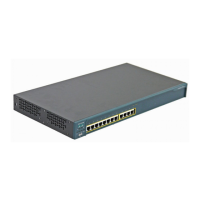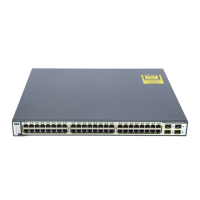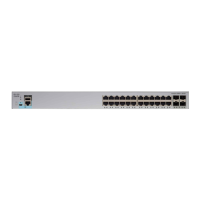7-21
Catalyst 6500 Series Switch Software Configuration Guide—Release 8.7
OL-8978-04
Chapter 7 Configuring Spanning Tree
Understanding How Multiple Spanning Tree Works
Common Spanning Tree
CST (802.1Q) is a single spanning tree for all the VLANs. In a Catalyst 6500 series switch running
PVST+, the VLAN 1 spanning tree corresponds to CST. In a Catalyst 6500 series switch running MST,
IST (instance 0) corresponds to CST.
MST Instances
MST supports up to 64 instances; each spanning-tree instance is identified by an instance ID that ranges
from 0–63. Instance 0 is mandatory and is always present. Instances 1–63 are optional.
With software release 8.3(1) and later releases, the instance ID can range from 0–4094. Instances 1–4094
are optional.
MST Configuration
MST configuration has three parts as follows:
• Name—A 32-character string (null padded and null terminated) identifying the MST region.
• Revision number—An unsigned 16-bit number that identifies the revision of the current MST
configuration.
Note You must set the revision number when required as part of the MST configuration. The
revision number is not incremented automatically each time that the MST configuration is
committed.
• MST configuration table—An array of 4096 elements representing all the possible extended-range
VLANs. The value of element number X represents the instance to which VLAN X is mapped.
VLAN 0 and VLAN 4095 are unused and are always mapped to the instance 0.
You must configure each byte manually. You can use SNMP or the CLI to perform the configuration.
MST BPDUs contain the MST configuration ID and the checksum. An MST bridge accepts an MST
BPDU only if the MST BPDU configuration ID and the checksum match its own MST region
configuration ID and checksum. If one value is different, the MST BPDU is treated as an SST BPDU.
When you modify an MST configuration through either a console or Telnet connection, the session exits
without committing those changes and the edit buffer locks. Further configuration is impossible until
you discard the existing edit buffer and acquire a new edit buffer by entering the set spantree mst config
rollback force command.
With software release 8.3(1) and later releases, if you configure the MST configuration on a switch that
is the VTP mode primary server for MST, all the other switches receive the MST configuration. For
detailed information on VTP version 3 MST propagation, see the “Understanding How VTP Version 3
Works” section on page 10-12.
